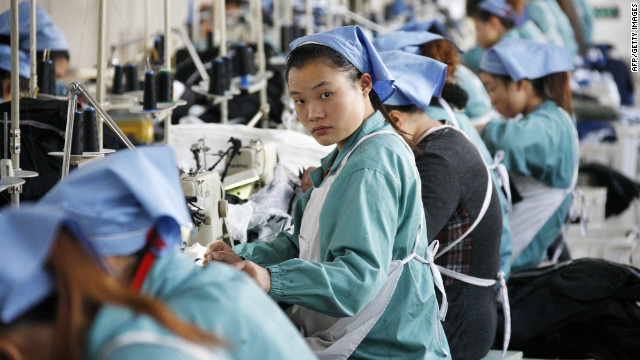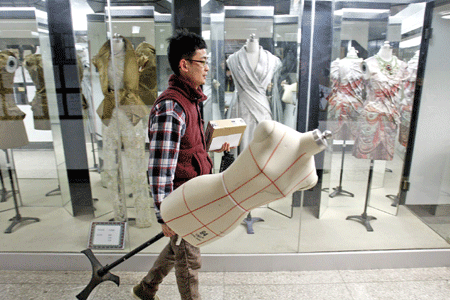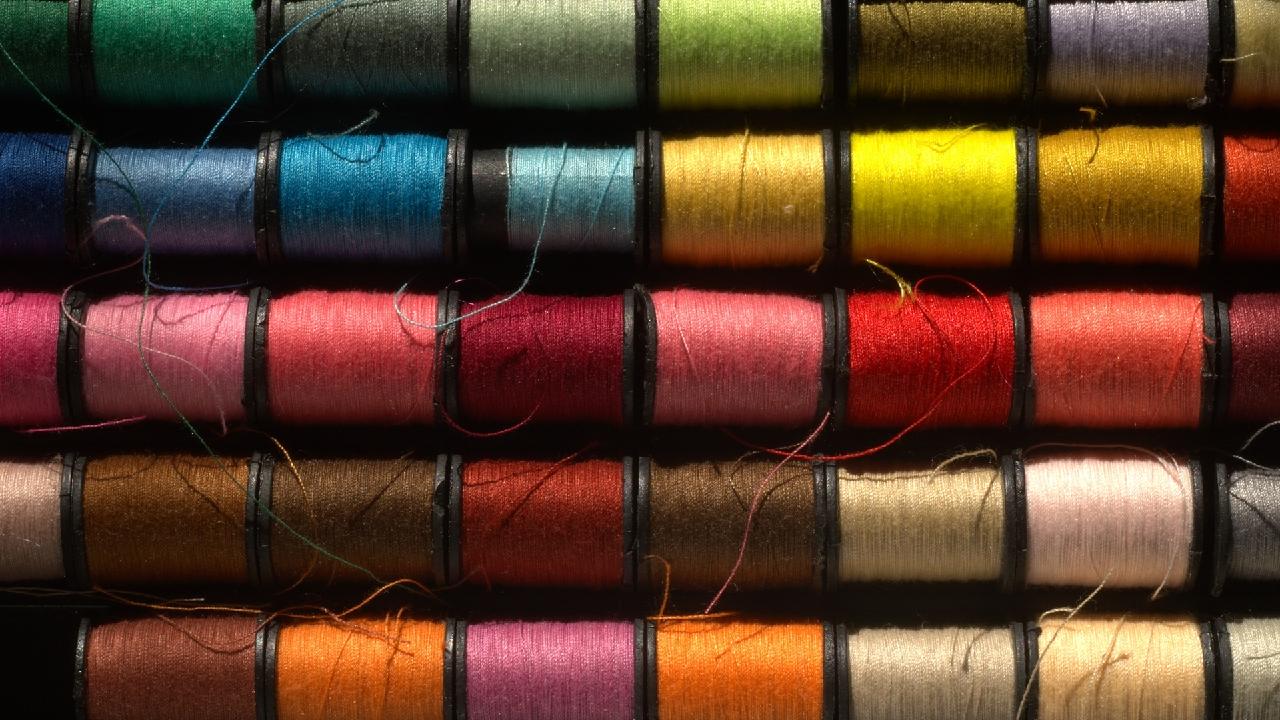|
AUSTRALIAN woolgrowers have cause for optimism. Man-made fibres and decades of drought eroded wool's market share but luxury houses have embraced it as the fabric of the future. It wasn't too long ago that the merino woolgrower was Australia's most reluctant martyr. Bullied out of global apparel market share by the post-war proliferation of cotton and synthetic fibres, then, later, bowed by oppressive drought, woolgrowers could have been excused for believing The Fates had abandoned them. For 20 straight years, the Australian merino flock size fell, and with rapidity: from 174 million head in 1990 to 68.1 million in 2010. Hit with the triple whammy of rock-bottom wool prices, growers had in part shifted their enterprise from wool production to the more profitable lamb and mutton sector; some left grazing altogether. Undeterred, the 50,000 or so remaining souls honed their craft with stoicism, applying better genetic breeding and smarter on-farm management. Then, amazingly, just as Australia's merino flock became thinner, the merino fibre became finer - from a national average of 22 to 23 micron (diameter measurement) in 1990, down to 19.8 micron in 2010. This was significant because, whereas coarse merino fibres (previously the bulk of our production) stick out and irritate skin cells, causing that itchy, scratchy feeling, fine fibres protrude and bend, making them ideal for soft, next-of-skin layering. At the superfine end of our wool market, around the 14 micron level, merino wool had entered cashmere territory. By virtue of this, and not without difficulty, by the end of the noughties Australian merino wool had again made itself indispensable to the world's leading fashion brands. But, as luck would have it, and god knows woolgrowers had seen none of that in years past, three other factors were playing out across both hemispheres that would guarantee wool's renewed relevancy. Firstly, a change of leadership at our woolgrower's not-for-profit representative body, the Australian Wool Innovation, would usher in an aggressive era for the marketing and championing of merino, pushing deep into emerging markets such as China, and getting our wool into the hands of Europe's top fashion designers. Secondly, the international luxury industry, long characterised by hype and glamour, was conspicuously returning to its working class roots. Luxury bellwether brands, such as Hermes and Louis Vuitton, began to celebrate the artisan as hero, talking up tenets of substance, value and accountability. Finally, and without doubt the knockout punch, in the UK in late 2009, a prince received a paltry sum of money for his estate's woollen fleece. His apocalyptic vision of a world without wool would set in motion the eco-centric Campaign for Wool, which would impact on the global wool industry in the most positive of ways. Call it justice, karma, or exactly what it was for our long-suffering woolgrowers: a miracle. In September last year, His Royal Highness, the Prince of Wales, new patron saint of wool, stood before a packed audience at La Galleria, in London's Pall Mall. Flanked by Academy Award winner Colin Firth and his wife Livia, Prince Charles addressed a crowd that included some of fashion's most influential names - designers Vivienne Westwood and Christopher Bailey, photographer Mario Testino and journalist Suzy Menkes, to name a few. The occasion was the opening of Wool Modern, an exhibition curated by Charlotte Lurot, that celebrates haute couture's creative use of wool. (A touring exhibition, it comes to Australia in April.) Surrounding HRH were works of sartorial art from designers including Christian Lacroix, Lanvin, Maison Martin Margiela, John Galliano and Westwood. "Babushka", a concept wedding dress designed by Yves Saint Laurent in 1965 made from 150 balls of wool and 6m of silk ribbon, had arrived in a heavily guarded glass case earlier that morning. The Prince explained to the gathering how, almost two years earlier, in January 2010, he had decided to launch the Campaign for Wool in an effort to save the wool industry. "When we discussed this campaign," he began, "it was clear that the wonderful properties of wool as a material for both interior design and apparel were being almost completely forgotten. This was a tragedy, I thought. A wonderful versatile and sustainable solution was being ignored in favour of fabrics made from non-renewable, fossil fuels ... and the fossil fuels, of course, are gradually running out." He continued: "Not only does [wool] leave a lighter footprint on the planet than man-made alternatives, it is also a better product. And when you consider how tough wool is and how long it actually lasts over its lifetime, it does represent the most tremendous value. So, whether it's a carpet made from the finest New Zealand wool, or for that matter from the fleeces of Cumbria's Herdwick sheep, that will still look good after many feet have travelled across it; or a suit made from Australian merino, which will last a lifetime; or a jumper made from a blend of British wool, which because wool breathes naturally will ensure you're never too hot or never too cold, these all outperform the man-made competition." Thanking the caterers, who were serving "renaissance mutton", the Prince concluded with a wry smile and some practical advice: "Ladies and gentlemen, the great thing about this is you can eat what was the original owner of the fleece; you can wear it, you can sleep on it, walk on it, insulate your house with it and attempt unsuccessfully to set fire to it. So, it won't do as much damage to you as man-made fibres. And if you do all these things, it will actually help to keep our family of farmers going and to maintain our precious landscape. That's the problem; it's understanding the virtuous circle in all of this, which is absolutely crucial for the future." Barely two hours before, just across the way at the Charing Cross Hotel, Vivienne Westwood, Conde Nast UK vice president Nicholas Coleridge and AWI chief executive Stuart McCulloch, among other panel members, were declaring their concern for wool's "virtuous circle". Westwood declared: "The first indication I had that there was a problem with wool was a year or so ago, probably two, on [BBC Radio's] Gardener's Question Time. The farmer was suggesting that the use of sheep's skin was very good for mulch, instead of straw, as ... the cost of shearing the sheep is more than the wool was worth. That was what he said and I was astonished. "I've never thought about not having wool; it's been so important to me ... I grew up with wool. I was born after the war and all the children learnt to knit at school. You just knitted everything, from little flowers for a lapel decoration, to hats with baubles on ... my mother used to knit us a pair of gloves in the evening, or socks. We would have them by the morning - she was the quickest knitter I've ever seen." Jeremy Hackett, founder of upmarket British suiting brand Hackett London, was equally effusive. "We can't consume enough wool. We're constantly buying it. I buy an enormous amount of tweed from the borders of Scotland - terrier tweed. I buy tweed from Exmoor; I buy woollens from the Shetland Isles to make into homespun knitwear; I buy Geelong [lamb's] wool, which is very fine - I believe it's the first cut of the sheep - a beautiful quality, very fine, very soft, which we make into sweaters." Taking a question as to whether merino wool should now be considered a luxury fibre, the AWI's McCullough, responded: "Yes, we think so. We're making a conscious decision to move back into that luxury segment. We know very well that fashion doesn't filter up and the very pinnacle of the fashion triangle is watched by all the others operating in that triangle. A strategy of ours is to focus on that luxury end. We believe that wool is that luxury end of the market and we're conscious that it will filter down into the mass markets." At this point, Conde Nast's Nicholas Coleridge, who is also the Campaign for Wool's vice chairman, grabbed the microphone to say: "I also think it's a luxury fibre. For sure. Particularly when you think of the alternatives to it. When you have a suit made here or you buy a suit made from wool, you can still be wearing it with such happiness 15 years later if you look after it well. I think the same thing is true of women's coats and skirts. A beautiful and well-made wool coat is something you wear for years and years and years. And I think that something that's made from synthetics ... [is] very seldom something you feel terribly proud of." As London was illustrating just how on-message the mature fashion markets are, Shanghai was pointing to the future. Preceding the start of Spin Expo - China's answer to the French textile fair, Premiere Vision - the AWI launched their fabric design laboratory, the Wool Lab, at new headquarters on a leafy street in Shanghai's French Concession. As a trio of violinists played Click Go the Shears, China's fashion designers, brand managers and textile overlords sipped champagne and pored over hundreds of merino-derived fabric swatches, the result of Australian wool's collaboration with the world's top weavers to proactively set the trends. In attendance were Ian and Phyllis Gill, of Jemala in Benalla, Victoria. Both in their early 70s, the Gills are merino's ultimate quiet achievers, having sold their fibre in the past directly to Chanel, Hermes and Louis Vuitton, before initiating their own knitwear brand that sells in limited amounts worldwide. "Oh, I miss my boys!" Phyllis says, as she pats the head of the life-size merino statue fronting the courtyard. In a quiet moment I ask Ian the significance of the launch of the Wool Lab in China. "Well, it brings the Australian merino fibre into the forefront thinking of Chinese designers, doesn't it?" he replies. "The Chinese in the past thought largely in terms of silk and now we're producing wool fibres nearly as fine as silk. Not in vast amounts, but enough to get into the area of high art and high quality artisan skills. When the Chinese were developing their skills in silk, wool was much, much, much coarser. Now we have wool down to 11 microns, which matches silk in diameter." "Wool has different properties," adds Phyllis. "Silk feels lovely against your skin but so does Jemala wool. And silk is a summer fibre [but it can get] sticky and uncomfortable to wear, whereas Jemala is inter-seasonal. Wool absorbs and breathes. And, of course, in very hot, humid weather silk does nothing to enhance body odours." I ask the Gills whether China is key to their future. "Yes, certainly," Ian says. "China is Jemala's future, because of the stability. But underpinning what's happening in China is their philosophical stance, which has been there for thousands of years. They are fundamentally Confucian, with family ties and cultural heritage. And that overrides, in the long term, all the current fashions, trends and political developments." Australian woolgrowers en masse continue to target China. In October last year, the AWI brought 25 Chinese womenswear designers to NSW, Tasmania and Western Australia to educate and inspire them as to the benefits of merino wool. As a result, the womenswear labels pledged to incorporate 30 per cent more wool into their collections by 2012-2013. Credit must go to the AWI. For an organisation marked in its past by rancorous infighting, the new AWI has its collective fingers on the pulse. "In China you've got a new generation of luxury brands, or aspiring luxury brands, that are locally created," explains AWI's global business development manager Sam Guthrie. "They've emerged after the international luxury brands came in and flooded the market and now you have local contenders who want to get up and fight on the same level. But they need to find their own way to differentiate themselves in those markets. "Now, as we know, luxury is driven by principles of heritage, provenance, quality, craftsmanship and the like. What the Chinese brands don't have, that the international brands all have, is the heritage. If you're comparing someone who we work with, such as (Chinese womenswear brands) Icicle or JBNY, those guys have really grown up over the past three to five years, so they see an opportunity in working closely with wool, particularly merino wool from Australia, to be able to leverage our heritage story in a marketing context, to be able to leverage the wonderful array of stories that wool-growing Australia can provide. Which isn't just about heritage, it's also about modern innovation and everything that's occurred on the farm to make the sheep and the fibre that's grown on the sheep modern and appropriate for today's apparel. So, that was the whole premise. It was, 'Let's bring the designers here. Let's inspire them by not only the animal but the people who grow the animal.' I don't think there's any other example in the world of a country that's been built on the sweat and innovation and passion of an industry in the same way as wool has contributed to Australia." In this sense, Australia's merino woolgrowers are in synchronicity with today's paradigm shift in the international luxury industry, which is regaling consumers with marketing tales of artisanal skill and historical legitimacy - two key attributes Australian wool has in spades. Not only that, but wool, with its sustainable, natural, renewable qualities, now represents the zeitgeist of the fashion industry. Then there is the tailoring factor. In much the same way as top chefs rely on the finest ingredients, merino wool is the best raw material to use in fashion construction. Its tailoring ability is second to none in that you can introduce temporary and permanent set in yarns and clothing. With polyester or cotton, this isn't possible; there is no crimp, stretch or give. You can't mould it. Wool also has intensity of colour, a depth of colour, whereas synthetic fibres colour on surface only. Therefore, it is not just fashionable but a fashion plaything. Australia's young designers seem to be switched on to this, too. At last month's G'day USA events, a clutch of young Australian designers showcased their work in wool, two highlights being Christopher Esber's silk and wool blend suiting, and Michael Lo Sordo's creative gold leaf finishing, which is incorporated into wool garments. So, where to from here? All indications are that the outlook is optimistic. The global clothing market is estimated to be worth $1.4 trillion annually, of which consumers of the OECD markets invest $80 billion in wool apparel. Wool's total market share of the global apparel market is 1.7 per cent, of which Australian merino wool makes up 0.45 per cent. Also, the Australian merino flock is now stabilised at around 74 million and growing at an estimated 5 per cent year on year, so supply is tight and wool prices should remain high and stay that way. However, for an industry that has supported Australia's economic growth and iconic rural way of life since our early European settlement, one would think it's now the Australian consumer's time to step up. Can't our winter football codes have a Wool Weekend of sorts and have the players in new performance-based wool jerseys to help spread the merino gospel? Can our schools not seek to get a pair of wool socks on every student with the same vigour as we pursue laptops? After all, when we consider wool's "virtuous circle", not to mention the tangible end result of keeping more Australian families on the land, it seems "un-Australian" for us to remain disengaged. |
|
Australian wool has become indispensible to leading fashion brands
Updated: 2012-2-3 Source: CTEI

Recommended News
Photo Gallery
Most Popular



